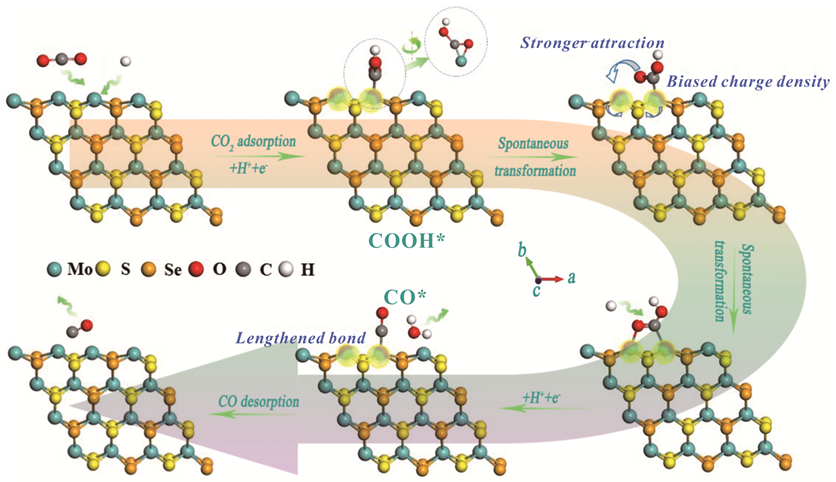Carbon Dioxide Electroreduction into Syngas Boosted by a Partially Delocalized Charge in Molybdenum Sulfide Selenide Alloy Monolayers
Prof. Yi Xie and Prof. Yongfu Sun’s group from the school of Chemistry and Materials Science in the University of Science and Technology of China (USTC) has recently achieved new progress in the field of CO2 electroreduction into syngas. This work has been published in Angew. Chem. Int. Ed. with the title of “Carbon Dioxide Electroreduction into Syngas Boosted by a Partially Delocalized Charge in Molybdenum Sulfide Selenide Alloy Monolayers”.
It would be extremely meaningful, if the syngas could be efficiently produced by environment-friendly means such as reduction of CO2 and H2O mixture by electrocatalysts, since it could not only decrease dependency on the fossil fuels but also reduce the amount of carbon dioxide in atmosphere. Of note, ternary TMDs alloy often exhibit boosted electrocatalytic performances relative to its two pristine binary TMDs, and in-depth understanding on the underlying reasons is still an open question. In this paper, MoSeS alloy monolayers, MoS2 monolayers and MoSe2 monolayers were successfully synthesized via a novel liquid-liquid interface-mediated strategy. DFT calculations illustrated MoSeS alloy monolayers had increased DOS at the conduction band, which allowed for faster electron transfer ability confirmed by their lowest work function and smallest charge-transfer resistance. Meanwhile, synchrotron radiation XAFS manifested the partially delocalized charge of Mo atoms, fairly agreeing with the optimized model, which not only benefited for stabilizing COOH* intermediate verified by its most negative formation energy, but also facilitated the rate-limiting CO desorption step by lowering the overlap between Mo d-orbital and C p-orbital in CO*, confirmed by the lowest CO desorption temperature/potential on MoSeS alloy monolayers. As a result, MoSeS alloy monolayers attained the highest 45.2% Faradaic efficiency for CO production, much larger than that of MoS2 monolayers (16.6%) and MoSe2 monolayers (30.5%) at −1.15 V vs. RHE. This work disclosed how the partially delocalized charge in ternary TMDs alloys accelerates electrocatalytic performances at atomic-level, opening new horizons for manipulating CO2 electroreduction properties.

Back
